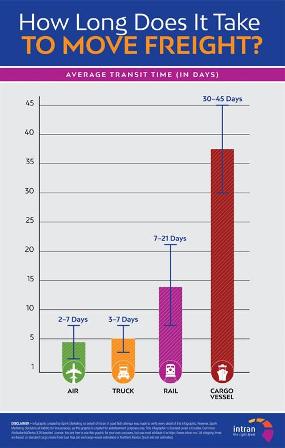A new infographic illustrates the transit times for importing manufactured products into the United States. The length of time it takes to move freight varies between two days and 45 days, depending on the mode of transportation.
 Utilizing statistics from the U.S. Department of Commerce and other reputable sources, the team at Intran was able to collect enough data to chart the estimated shipping times and the advantages and disadvantages for each option.
Utilizing statistics from the U.S. Department of Commerce and other reputable sources, the team at Intran was able to collect enough data to chart the estimated shipping times and the advantages and disadvantages for each option.
“Almost 90 percent of global trade goods are transported by sea, and we discovered that the average cargo ship travels a distance that equals three-quarters of the way to the moon and back every year,” says Juan Cintron, Intran’s CEO. “Imagine taking a boat almost to the moon and back. That equates to a lot of time, and we all know time is money.”
Receiving goods from Mexico and Canada means ground travel is readily available and shortens the supply chain. No matter how goods are transported into the US, there are always fees to consider. Packaging, handling, container and fuel prices fluctuate, contributing to the varying shipping costs. Weather and docking delays can also affect cost and delivery, but the graphic focuses on averages.
Here are some facts about the chart’s featured shipping methods:
- Air freight can deliver goods to their destination within two to seven days but is cost prohibitive. While companies can ship parts on pallets or in containers with planes, the weight of the cargo can eliminate this shipping option or result in astronomical shipping fees. The World Bank estimates that air shipping costs up to five times as much as road shipping. This quick-delivery method may be imperative for fresh seafood but not necessary for non-perishable goods.
- Trucks aren’t quite as fast as planes, but they don’t run on the stringent schedules of trains. Cargo that’s trucked in to the U.S. generally arrives within three to seven days, comparable to air transport. The amount of cargo a trailer can handle varies by axles but most average anywhere from a 46,000-pound to 66,000-pound maximum payload. A standard pallet carries up to 4600 pounds, so these trucks can move a decent amount of product quickly.
- Shipping by rail can take anywhere from seven to 21 days for the product to hit its destination. Of course, the time and cost of this shipping can include some intermodal transport, using trucks to get the cargo to the train and to the warehouse. Rail shipping means pallets and containers can be used to move goods, and trains do get noteworthy miles per gallon. According to Global Trade magazine, one ton of freight can be transported 400 miles on a single gallon of fuel. This can offer big savings on shipping rates for those moving heavier products.
- According to the U.S. Department of Commerce, a container vessel traveling from Asia to the United States takes anywhere from 14 days to 33 days. Using slow steam means the ship reduces emissions and increases travel time. The goods that arrive in a U.S. port often stay there for another five to six days. A few more days are added to the graphic to account for the on-land travel that takes cargo to the ship. Goods that travel the ocean can take up to 45 days to arrive at a U.S. destination.
See the full graphic here: https://www.intran.mx/freight-moving-time/





